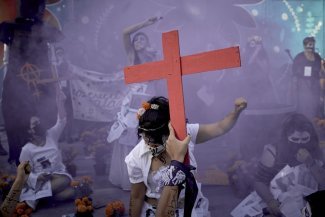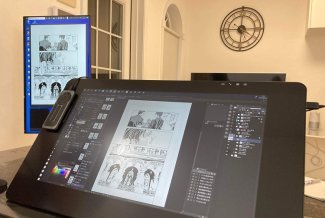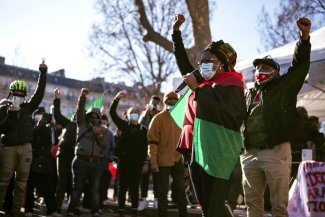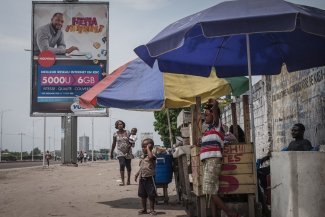Marching with hundreds of protesters on 4 December in lower Manhattan, protesting the non-indictment of Daniel Pantaleo, the police officer who choked an unarmed black man named Eric Garner to death this summer, 27-year-old architect Chris McCormick recalled that he once had a sense of optimism about the American criminal justice system.
That changed this week.
Holding a sign which read “Am I next?” McCormick said, “I don’t think it’s the police. It starts with the system.” Indeed, that seemed to be the sentiment of many of the marchers. Waving black flags, many chanted, “Eric Garner, Michael Brown, shut the whole system down.” One sign read: “Choke the system.”
The anger in the Garner case this week was still simmering when the news of another unarmed black man, 34-year-old Rumain Brisbon, had been shot and killed by police in Phoenix.
Already, the nation was reeling from a similar non-indictment in Ferguson, Missouri, in the shooting Michael Brown, an unarmed, black 18-year-old.
And in the Ferguson case, when protests erupted after the killing this summer, the nation witnessed an outrageous police response, with a suburban force armed with tanks and military gear.
The idea that small towns all over the country were fully militarised seemed unconscionable even to political moderates. Yet, even the shock of the rapid militarisation of American police, accelerated during the rise of the War on Drugs in the 1980s, doesn’t fully grasp the epidemic facing the black community.
A surplus of military hardware toward the end of the Cold War found new homes in local police forces as the country embarked on more aggressive anti-drug policing.
The trend of earmarking funds for such equipment to be bought and used domestically increased after the 9/11 attacks and the creation of the Department of Homeland Security.
But the deaths that spark these protests aren’t the result of military hardware. Michael Brown was killed with a pistol and a plain-clothes cop simply asphyxiated Garner; his death was ruled a homicide by a medical examiner, and his last words were “I can’t breathe” repeated over and over again.
The alleged crimes of these suspects were minor. Brown, contrary to popular opinion, was picked up for blocking car traffic. Garner was being arrested on suspicion of selling untaxed cigarettes.
The militarisation is ingrained in the frontline force. With militarisation, police don’t see themselves as public servants but as warriors in an endless conflict, the enemy combatants are anyone suspected of committing a crime.
Reforms
New York Mayor Bill de Blasio has promised new reforms in police training so that cops use more restraint on the street. US President Barack Obama has tried to address the epidemic by announcing plans to equip US police officers with body cameras, amongst other measures. It is hoped that video evidence of police abuse will help temper police activity.
But already police reform advocates are skeptical. The Garner incident was caught on camera yet a Grand Jury still let Officer Panteleo off the hook. Brooklyn College sociologist Alex Vitale, who has studied the tactics of the New York Police Department, told Equal Times:
“Body cameras are only as effective as the accountability mechanisms in place. If local District Attorneys and Grand Juries are unwilling to act on the evidence then the courts won’t be an effective tool for accountability, even with cameras.”
He continued: “It is possible that cameras will lead to more civil litigation and more internal disciplinary procedures. It is quite possible that the city will have to pay out large damages to the Garner family and that one or more of the officers involved may be disciplined or even fired over their actions.
“The combination of critical media coverage and protest action can have the effect of shifting public opinion sufficiently or creating a governing crisis that political leaders have to adjust,” he said.
“So, as long as there are controls over the data and how it’s used, I’m in favor of them, but I expect their impact to be limited in the absence of either strengthened accountability mechanisms or significant social movement pressure.”
Human rights campaigners have been calling for more safeguards and protection from police abuses, however these mechanisms already exist and are easily manipulated or systemically ineffective.
For example, in both the Garner and Brown incidents, it seemed unlikely that the prosecutor would anger the police rank and file by securing an indictment, since prosecutors depend on having a good relationship with the police to do their day-to-day job.
Changing the system
Fixing the problem of unarmed – and disproportionately – non-white people, enduring police brutality and even death at the hands of cops is not so much about training or equipment.
As the protesters in lower Manhattan chanted, it is about changing the system.
In its essence, that means taking the national focus away from treating social ills, or even public expressions of dissent, as criminal problems.
As Senator Rand Paul said, it’s about emphasising the fact that “confronting protesters with armoured personnel carriers is thoroughly un-American.”
In some respects, that change is already happening. Drug policy reform has gained some success, with decriminalisation in Washington, Colorado and other states. But it will also mean addressing joblessness and homelessness, and providing more services for working people and putting more money into education.
There are some rays of hope; the Contra Costa Times, for example, reported that police in Richmond, California have implemented procedures to greatly reduce the use of force.
But the recent killings prove that even the right tactics aren’t enough to save black lives.
Brown had his hands up. The Garner incident was videotaped. The South Carolina officer who was caught on camera shooting Levar Jones – who was pulled over for not wearing a seatbelt – was charged, but that’s considering the extremity of the situation: Jones, who survived, was shot for complying with police orders.
The real substantive change will have to come in the form of addressing racial divisions and racism. That’s a long term struggle, one that recognises that police brutality is for today’s civil rights movement what voting rights was just a few generations ago.









